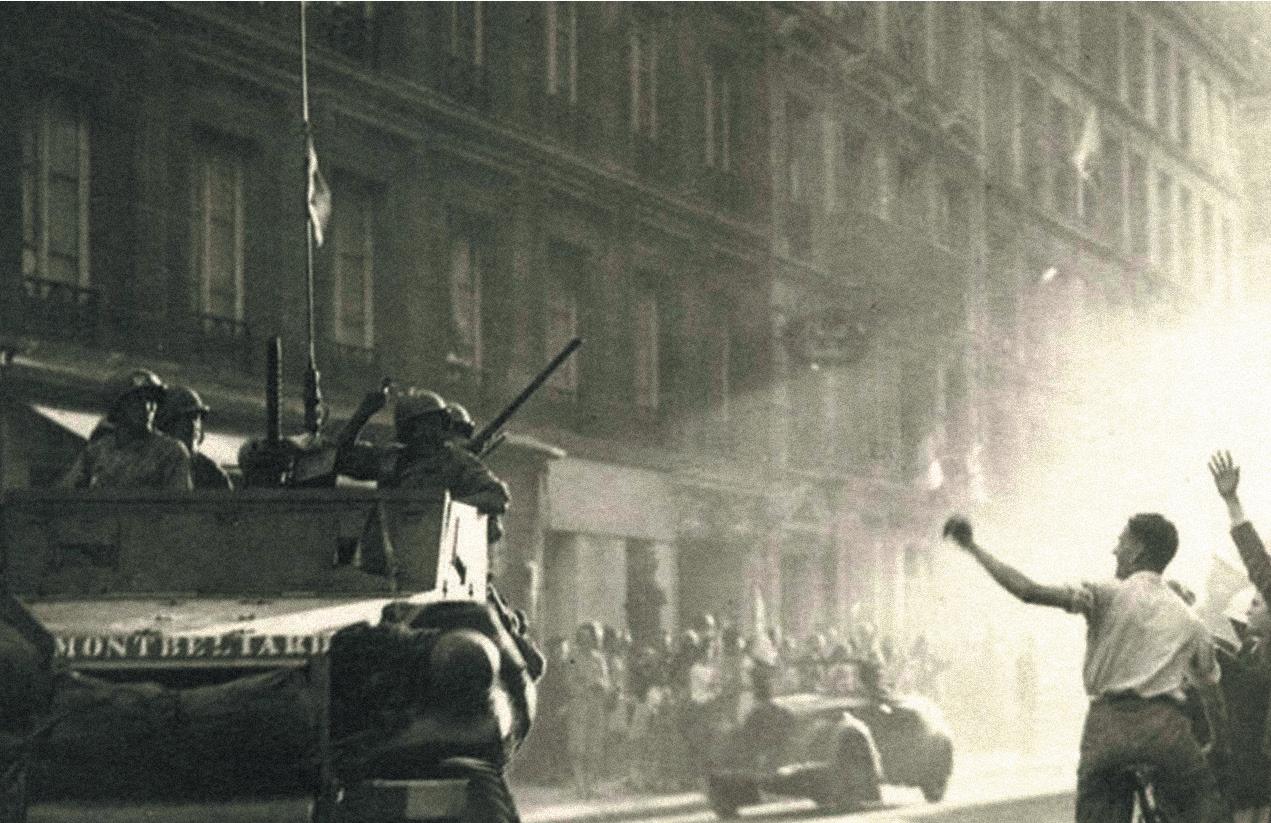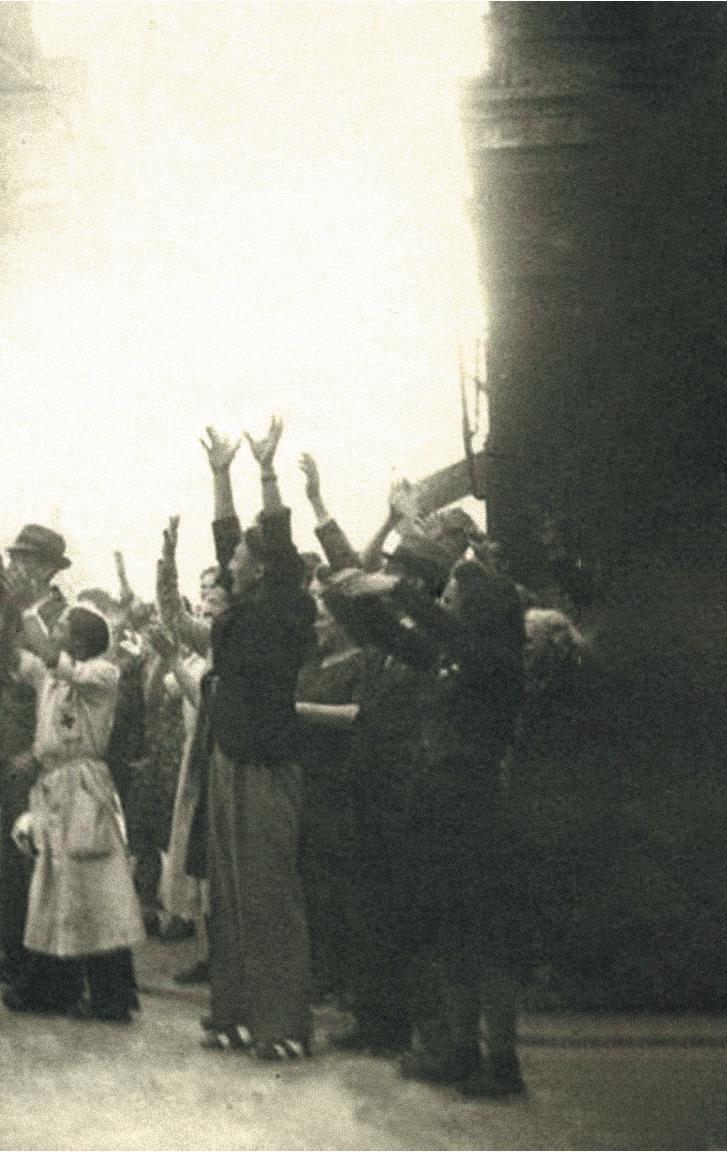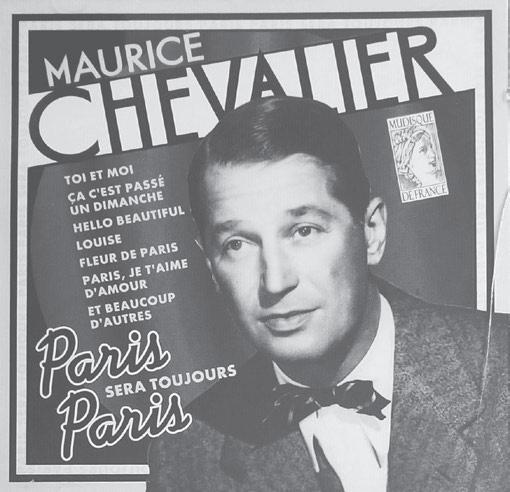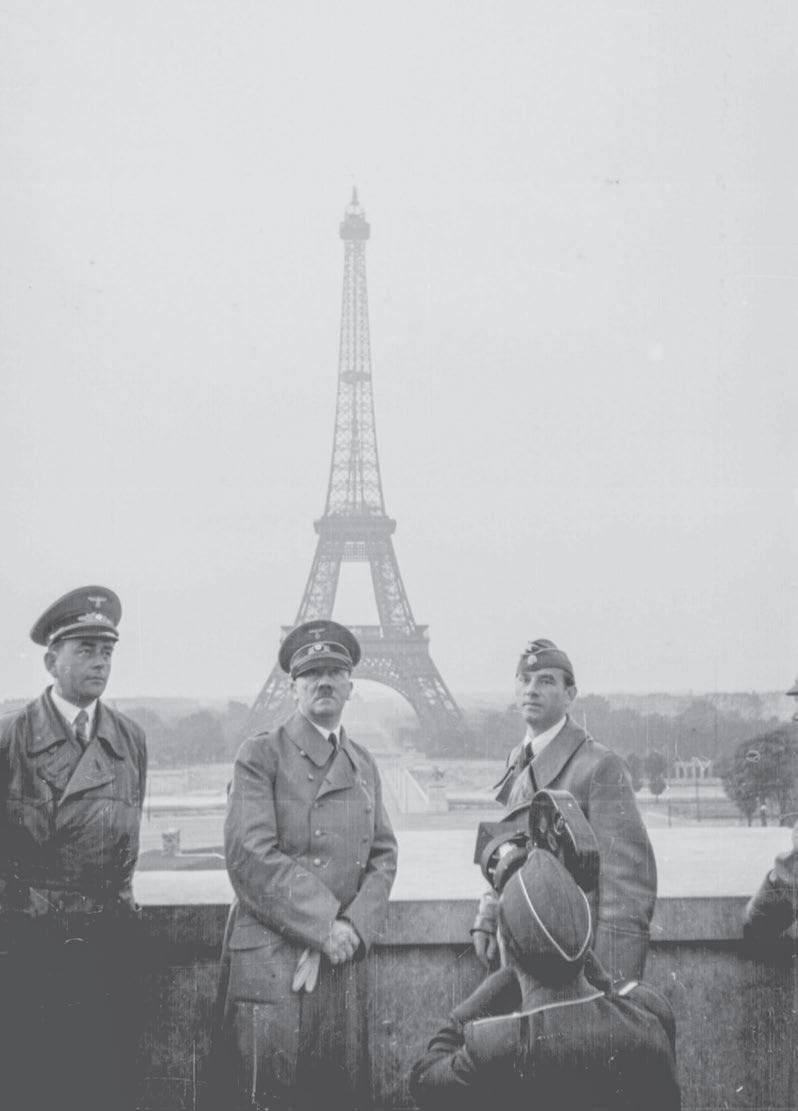PARIS ’44
THE SHAME AND THE GLORY



PRAISE FOR PARIS ‘44
‘An evocative account of the city’s liberation . . . Bishop is such a skilful writer, with a sense of nuance and an eye for memorable anecdotes, that even readers familiar with the story will enjoy his book enormously . . . history, like life, is complicated, and Bishop’s admirable book treats it with the respect and care it deserves’ Dominic Sandbrook, Sunday Times
‘Paris ’44 tells the story of the occupation and the liberation, but it does not read like military history . . . The book resembles some epic thriller, with vividly evoked characters all somewhere on the spectrum between collaboration and resistance, shame and glory . . . Paris ’44 is a wonderful book: droll, moving, with a cinematic eye and not a boring line in it’ Andrew Martin, Observer
‘Bishop pulls no punches in emphasizing that the story of Paris’s liberation from the Germans by its brave citizens was a myth, invented for political purposes by Gen. Charles de Gaulle . . . This is a thrilling account of a notable episode of the last phase of World War II , told with authority as well as a wealth of unpublished anecdotes’ Max Hastings
‘Patrick Bishop follows a tradition of British and American historians interrogating aspects of wartime history that the French themselves prefer to avoid. His beady-eyed Paris ’44 takes a panoramic view of crumbling Nazi administration, approaching armies, foreign correspondents, Resistance fighters, opportunist Gaullists and various collaborators, sharply depicting the faultlines of rivalry among the liberators’
Roy Foster, TLS Books of the Year
‘How close Paris came to being laid waste – and many of its citizens being massacred in an almighty bloodbath – is vividly and thrillingly recounted by British war historian and Paris resident Patrick Bishop. We re-live the tension of those terror-filled days’ Tony Rennell, Daily Mail
‘Fascinating . . . gripping . . . Bishop tells the story of the liberation by reporting, as if he were there, how a rich cast of characters lived through its key moments’
Nicholas Farrell, Sunday Telegraph
‘Gives a vivid impression of what it might have been like to be there on that wonderful day . . . for those who prefer their history to be romantic, this book is the one. It’s all here . . . in full Technicolor, told at a blistering pace’ Spectator
‘By far the best written study in English of this controversial topic of France under German rule . . . filled with charming anecdotes and lively sketches of the key figures in the liberation of Paris . . . What Bishop has produced is a nothing less than a love letter to the city of Paris’ John Rossi, New Criterion
‘Excellent . . . a fresh, unexpected take on the liberation of Paris’ Julian Jackson, author of France on Trial: The Case of Marshal Pétain
‘An extraordinary moment of history brought to vivid, pulsing life. Rich with suspense and layered with intrigue’ Sinclair McKay, author of Berlin
‘Bishop writes with admirable brevity and insight’ Sunday Times
‘A fascinating narrative about a little-known period of Parisian history with a cast of characters worthy of a Balzac or Victor Hugo novel. Yet, this isn’t fiction – it’s a meticulously researched account full of surprising anecdotes and fascinating people that unveils much about modern-day Paris’ Edward Chisholm, author of A Waiter in Paris
About the A uthor
Patrick Bishop is one of Britain’s leading historians of warfare, the author of critically acclaimed bestsellers such as Fighter Boys, Bomber Boys and Air Force Blue, which highlight the human side of conflict. He is the former Paris bureau chief of the Daily Telegraph.
Paris ’44
The Shame and the Glory
PENGUIN BOOKS
UK | USA | Canada | Ireland | Australia India | New Zealand | South Africa
Penguin Books is part of the Penguin Random House group of companies whose addresses can be found at global.penguinrandomhouse.com.
Penguin Random House UK , One Embassy Gardens, 8 Viaduct Gardens, London SW 11 7b W penguin.co.uk
First published by Viking 2024 Published in Penguin Books 2025 001
Copyright © Patrick Bishop, 2024
The moral right of the author has been asserted Penguin Random House values and supports copyright. Copyright fuels creativity, encourages diverse voices, promotes freedom of expression and supports a vibrant culture. Thank you for purchasing an authorized edition of this book and for respecting intellectual property laws by not reproducing, scanning or distributing any part of it by any means without permission. You are supporting authors and enabling Penguin Random House to continue to publish books for everyone. No part of this book may be used or reproduced in any manner for the purpose of training artificial intelligence technologies or systems. In accordance with Article 4(3) of the DSM Directive 2019/790, Penguin Random House expressly reserves this work from the text and data mining exception Typeset by Jouve (UK ), Milton Keynes Printed and bound in Great Britain by Clays Ltd, Elcograf S.p.A.
The authorized representative in the EEA is Penguin Random House Ireland, Morrison Chambers, 32 Nassau Street, Dublin D 02 Y h 68
A CIP catalogue record for this book is available from the British Library IS b N : 978–0–241–99154–1
Penguin Random House is committed to a sustainable future for our business, our readers and our planet. This book is made from Forest Stewardship Council® certified paper.
To old friends, old comrades:
Richard, Teresa, Nina, Mark, Felicity, Keith, Claire, Laura, Xan, Jane, Viv, James, Charles and Tina.
Images in the text
List of Illustrations
p. 2: Maurice Chevalier
p. 13: Adolf Hitler in Paris (Universal History Archive / UIG / Bridgeman Images)
p. 16: Marty and Ernest (CSU Archives / Everett Collection / Bridgeman Images)
p. 27: Anton Prinner (© LIMOT / Bridgeman Images)
p. 41: Exodus (Bundesarchiv)
p. 55: Pétain Poster (Pictorial Press Ltd / Alamy Stock Photo)
p. 64: Jewish women wearing the Star of David (© SZ Photo / Scherl / Bridgeman Images)
p. 79: Hunger
p. 84: Cécile Rol-Tanguy
p. 97: Rose Valland
p. 111: Gerda and Bob (© Fred Stein / Bridgeman Images)
p. 119: Philippe Leclerc
p. 130: Sacré Coeur (Keystone-France / Getty Images)
p. 137: L’A ffiche Rouge (GRANGER - Historical Picture Archive / Alamy Stock Photo)
p. 152: Bocage (Pictorial Press Ltd / Alamy Stock Photo)
p. 167: Jerry Salinger
p. 177: Parisiennes use their compact mirrors to view Henriot’s funeral
p. 181: Madeleine Riffaud
p. 193: Alexandre Parodi
p. 208: ‘The Gentleman of Paris’ (© AGIP / Bridgeman Images)
p. 215: Defending the prefecture (AFP / Getty Images)
p. 227: SS victims at the Chateau de Vincennes (PWB Images / Alamy Stock Photo)
List of Illustrations
p. 233: Eisenhower and De Gaulle (Photo 12 / Alamy Stock Photo)
p. 245: La Tondue de Chartres (© Robert Capa / ICP / Magnum Photos)
p. 248: Barricade (Chronicle / Alamy Stock Photo)
p. 251: Georges Dukson
p. 268: Some soldiers of La Nueve with a half-track
p. 275: Dronne at the prefecture with Chaban-Delmas (Musée de la Prefecture de Police de Paris)
p. 279: Crowd celebrates the liberation (© AGIP / Bridgeman Images)
p. 292: De Gaulle’s speech
p. 300: Rough justice (© Usis-Dite / Bridgeman Images)
p. 304: Alexandre Rosenberg
p. 314: Fighters in the police prefecture (Shawshots / Alamy Stock Photo)
p. 317: Judgement Day (Universal History Archive / Getty Images)
p. 327: Plaque in Paris
Plate sections
1. The rue de Rivoli (Keystone-France / Getty Images)
2. The face of Vichy: Pétain and Laval (PVDE / Bridgeman Images)
3. Soldiers were promised ‘Jeder einmal in Paris’ [‘everyone gets to see Paris once’] (© SZ Photo / Scherl / Bridgeman Images)
4. Ernst Jünger and comrade on the roof of the Majestic (Bridgeman Images)
5. Tandem vélo-taxi taking punters to the Longchamp races (Roger-Viollet / TopFoto)
6. Pierre Georges – aka Colonel Fabien
7. War tourist: Robert Brasillach with French LVF volunteers in German uniform on a trip to the eastern front (© Tallandier / Bridgeman Images)
8. Von Choltitz calls it a day (© Paulka / Bridgeman Images)
9. Leclerc and the 2DB (© Tallandier / Bridgeman Images)
10. Ernest von Clausewitz (© SZ Photo / Sammlung Megele/ Bridgeman Images)
11. J. D. Salinger in his beloved jeep
12. Moment of decision: De Gaulle explains to Ike why the plan has to change (Photo 12 / Alamy Stock Photo)
13. Béatrice Briand (© Tallandier / Bridgeman Images)
14. Fifis (© Archives Charmet / Bridgeman Images)
15. Soaking up the sun at the Piscine
16. Raymond Dronne plans a clearing operation (Keystone-France/ Gamma-Keystone via Getty Images)
17. Brothers in arms (© Galerie Bilderwelt / Bridgeman Images)
18. Welcome to Paris (Bridgeman Images)
19. Resistance thoroughbreds: Henri Rol-Tanguy, reviewing his men at the Reuilly barracks after the fighting (Everett Collection / Bridgeman Images)
20. Jacques Chaban-Delmas (© AGIP / Bridgeman Images)
21. Vengeful Parisians (World History Archive / Alamy Stock Photo)
22. Femme Tondue (© SZ Photo / Scherl / Bridgeman Images)
23. The 26 August victory parade sets off down the Champs-Élysées. (Bridgeman Images)
24. Madeleine Riffaud and Pablo Picasso
25. A toast to victory (Granger / Bridgeman Images)
26. A myth is born (Bridgeman Images)
Maps



Paris, 1944


Bois de Boulogne
Avenue de la Grande Armée Avenue Poincaré River Seine
Arc de Triomphe
Avenue Kléber Avenue Foch Avenuede Wagram
Place de l’Étoile
Hôtel Majestic
Rue de Pressbourg Avenue Montaigne
Boulevard des Batignolles
Parc Monceau
Rue la Boétie
Rue du Faubourg Saint Honoré
Rue Royale
Place de la Concorde
Palais Bourbon
Rue Dominique
Eiffel Tower Les Invalides
École Militaire
Gare Montparnasse
Rue du
Sacre Coeur Basilica
Barbès-Rochechouart Métro station
Place de l’Opéra
Rue Saint-Honoré
Boulevard des Capucines
Place Vendôme
Hôtel Meurice
Jardin des Tuileries
Louvre
RuedeRivoli
Rue duFaubourgSaint-Denis
Place Denfert-Rochereau Concorde
Gare du Nord
Avenue de la Porte de la Villette RuedeFlandre
Gare de l’Est
Boulevard Saint-Martin
Place de la République
Hôtel de Ville
Préfecture de Police Notre Dame Cathedral
BoulevardSaint-Germain
Palais de Luxembourg
Jardin du Luxembourg
Boulevard Montparnasse
Boulevard Saint-Michel
Île SaintLouis Île de la Cité
RueSaint-Jacques
Boulevard Raspail
Avenued’Orléans
Place d’Italie
Boulevard Henri-IV
Gare de Lyon
Porte d’Italie


















Central Paris, 1944










ChampsÉlysées
Place Vendôme
Opéra Garnier
BoulevarddesCapucines Avenue de l’Opéra
Rue du Mont Thabor
Hôtel Ritz A
Rue de Castiglione Rue d’Alger
Rue du Marché Saint-Honoré
RueSaint-Honoré
Jardin des Tuileries
Gare d’Orsay
River Seine
Quai des Grands Augustins
BoulevardSaint-Germain
Palais Royal
Rue du Four RuedeRivoli
Ruede Rennes
Préfecture de Police Louvre
Pont Neuf
Rue des Grands Augustins
Café de Flore
Rue de Savoie
Rue Saint-André des Arts
Rue de Tournon
Palais du Luxembourg
Jardin du Luxembourg
BoulevarddeMontparnasse
Boulevard Raspail
Tour Saint-Jacques
Boulevard du Palais
Île de la Cité
Pont Saint-Michel
Place SaintMichel
Notre Dame Hôtel de Ville Sainte-Chapelle
Petit Pont
Rue de la Huchette
Musée de Cluny
Rue Monsieur Le-Prince
Odéon theatre
École des Mines
Boulevard Saint-Michel
Lycée Louis-le-Grand
École Normale Superieure
Île Saint-Louis
Hôtel Meurice
Jeu de Paume gallery A B C







Ministère de la Marine




















2DB and US 4th Infantry Division March on Paris, August 1944
2DB northern column

2DB southern column southern route taken by US 4th Infantry Division

0 10 km
0 5 miles
River Seine
Pont de Sèvres
Sèvres
Versailles
River Bièvre
La Croix-de-Berny
PARIS
Limours
R i v e r Yvette
L’Haÿ-les-Roses
Antony Fresnes
Longjumeau
Arpajon
Introduction
In the early summer of 1945, the maternity wards of Paris were suddenly very busy. The upsurge in births was a living, breathing legacy of what had been the party of the century, that glorious Friday in August 1944 when Paris was liberated from the Germans, setting off an explosion of happiness that echoed round the world. The American war reporter Ernie Pyle arrived by jeep to witness: a pandemonium of surely the greatest mass joy that has ever happened . . . We all got kissed until we were literally red in face, and I must say we enjoyed it . . . when the jeep was simply swamped in human traffic and had to stop, we were swarmed over and hugged and kissed and torn at. Everybody, even beautiful girls, insisted on kissing you on both cheeks . . . the fact that I hadn’t shaved for days, and was gray-bearded as well as bald-headed, made no difference.
Among the population, the longing for deliverance was so deep that some feared at first that the American uniforms in the streets must be a hallucination. ‘But no, I am not dreaming,’ wrote a middle-aged man of letters, Gustave-Jean Reybaz, in his diary. ‘The nightmare of occupation is finally at an end and Paris has rolled away the stone of its own tomb and is reborn again.’
The eruption of exhilaration and relief reflected the unique position that Paris held in the world’s affections. Its fate mattered to almost everybody. In November 1939, three months into the strange interlude of inaction before fighting erupted in the west, which the French called the Drôle de Guerre and the British the Phoney War, Maurice Chevalier recorded a reassuring song. ‘Paris sera toujours Paris’ was a message to the world that whatever Hitler threw at the place, ‘Paris will always be Paris.’ The verses described the boardedup statues, taped-over windows, gas masks, rationing, air-raid sirens
and blackouts now marring the beauty of everyone’s favourite city. But the refrain promised:
In spite of all the gloom and dark The city we all love – you’ll see! Will never, ever lose her spark Paree will always be Paree The more they dim the lighting The more we’ll come back fighting Our spirit and our humour floating free Paree will always be Paree!

The defiant tone struck a chord everywhere and the song was a hit, becoming a staple of Chevalier’s repertoire. As prophecy it was a flop. Seven months later the German army walked into Paris unopposed, the start of more than four years of suffering, humiliation, deprivation and shame. Maurice Chevalier survived the occupation. Casimir Oberfeld, the man who composed the song, did not. He was one of 77,000 Jews sent from France to extermination camps by the German and French authorities and died in January 1945, freezing to death on a forced march just as the Russians were closing in on Auschwitz.
In 1949, four years after the end of the war, Josephine Baker recorded another song about Paris. Baker was born in America but rose to fame in France, where she lived for the rest of her life. Unlike Chevalier, who would later be accused of collaboration, Baker had an impeccable war record for which she was awarded the Resistance
Medal and the Légion d’Honneur. In ‘Paris, Paris’ she celebrated her adopted home town: a ‘corner of paradise’, ‘favourite of all my loves’, its ‘charm and elegance / the very soul of France’. This too was a hit, signalling that after all the tribulations of the occupation the city was back to its old self. Paris was doubly lucky. It emerged from the war with both its buildings and its reputation mostly intact. The process of rehabilitation began while the party was still in full swing. The liberation morphed from historical fact to legend overnight. The story of what had happened and what it meant was shaped by the man whose presence dominated the first delirious days of freedom. ‘Paris! Paris outraged! Paris broken! Paris martyred!’ declared Charles de Gaulle in a carefully crafted speech delivered on his arrival on the great day. He continued triumphantly: ‘But Paris liberated! Liberated by itself, liberated by its people with the help of the armies of France, with the help and assistance of the whole of France, of that France which fights, of the only France, of the true France, of the eternal France.’
De Gaulle was delivering what we might today call ‘his truth’, but it did not sit easily with the facts. Given the very limited scale of the uprising, could the people of Paris really be said to have liberated themselves? The ‘armies of France’ amounted to one armoured division, the 2ème Division Blindée (2DB ), which was entirely equipped by the Americans, and the first of its troops to enter the city were mostly Spanish republicans, refugees from the civil war. The 2DB’s firepower had been greatly reinforced by the presence of the American 4th Infantry Division, following close behind in case things went wrong. The ‘whole of France’ had played no direct part in the liberation. The one ‘true’, ‘only’ and ‘eternal’ France was a Gaullist invention. The nation rarely agreed on anything and the occupation had only opened another bitter chapter in a long history of discord.
But these were all mere facts and when confronting the newly minted legend they were bound to come off worse. De Gaulle had understood brilliantly the power that the city on the Seine exercised over the world’s imagination. It was loved as if it was a person rather than a place. People would believe what they wanted to believe, and no one wanted to think badly of someone they cherished.
At its heart, Paris was as much an idea as a reality. Its identity had
been built collectively by both its inhabitants and a multitude of outsiders, many of them artists of various kinds who had the status of honorary citizens. Among them were Ernest Hemingway and Pablo Picasso, who had done much to give the twentieth century its voice, shape and colour, and both of whom were on the star-studded guest list at the liberation party. Paris was part of who they were and a host of wannabe Hemingways and Picassos had moved to the city hoping some of its magic would rub off on them. Paris: the two syllables conjured a world of endless possibilities where fantasies of romance and fulfilment could come true. It was the self-proclaimed capital of freedom and tolerance, the very things the Nazis wanted to smash to pieces. When Paris fell, it was as if a great beacon had been extinguished. When it rose again, the light blazed out once more and the struggle against the forces of darkness seemed as good as won.
There was some truth in this rosy rendering of events. But the real story is more complicated and more interesting. This book is an attempt to tell it truly while never denying the power and authenticity of the myth. I write as a devotee who first hitchhiked to Paris with a friend when we were just eighteen, pitching a tent in the campsite in the Bois de Boulogne and subsisting until our money ran out on bread, cheese and red wine that came in plastic bottles. I have lived there on and off for years, yet each morning, as I step through the heavy door of the apartment block and into the bustle and show of the street, I feel the same surge of pleasure and anticipation as the first time I went there and everything was new.
I have tried, where possible, to relate events through the eyes and actions of an ensemble of those who were part of the mighty drama, both locals and foreigners. Some, like Hemingway, Picasso and J. D. Salinger, are legends. Others, like the fascist writer Robert Brasillach and the communist leader Henri Rol-Tanguy, merely well known. Then there are those you may never have heard of, though it is time that you did. They include a medic turned Resistance gunwoman, an androgynous Hungarian sculptor and a French bluestocking who quietly set about saving the nation’s art treasures from the Nazi looters. All played some role, big or small, in the great events that follow.
As well as freedom, liberation brought judgement. The chaos and
the ever changing odds offered opportunities for the quick-witted to dodge one fate and embrace another. No one did this more successfully than one of the story’s prominent characters: the city’s German military commander, General Dietrich von Choltitz of Is Paris Burning? fame. A man described by his captors as ‘a cinema-type German officer, fat, coarse and be-monocled’, who until then had been Hitler’s loyal servant, was able to recast himself as the city’s saviour, another myth built, as we shall see, on shaky foundations.
The lives of these men, women and teenagers converged that August in eleven days of drama, joy and bloodshed. Almost all the actors are now dead. If they could rise from their graves and tread the streets once more, they would find Paris much as they remembered it – proud and beautiful, interestingly raw and grimy behind the smooth exterior and above all, like this story, full of ambiguities.
Prologue: The Diabolical Tourist
It was a glorious morning in June 1940 and Arno Breker was at his house in the southern suburbs of Berlin. A golden mist floated over the city and the scent of pines from the Grünewald filled the air. He had to remind himself there was a war on. The silence was broken by the ring of the telephone. It was still only 7.15. Who could be calling this early?
‘Geheimstaatspolizei,’ said the voice at the other end. ‘You are going on a short journey. A car will be outside in an hour.’ Breker tried to find out more, but the line went dead. He felt a stab of alarm. What could the Gestapo want with him? He steered clear of politics. It was true he was Hitler’s favourite sculptor but that, he told himself, was due solely to his talent, not because he cared much for Nazi ideology.
He turned to his Greek-born wife Demetra who was hovering by his side. What could it mean? Breker’s first thought was to ring his friend Albert Speer, who was Hitler’s chief architect and a member of the Führer’s inner circle, but then he remembered that Speer had been out of town for days. Argument with the Gestapo was futile and could only make things worse. There was nothing to do but pack a bag – and wait. An hour later the doorbell rang. Two SS officers stood outside. Breker hugged Demetra goodbye. They were both ‘worried though neither of us admitted it. We knew that under a dictatorship anything was possible.’
The car sped through the Grünewald. All the sculptor’s attempts at conversation were ignored. They skirted the Havel lake and turned west. They were not going into Berlin then. Soon afterwards they drew up at a small airfield: Laaken. A three-engine Junkers Ju-52, the workhorse of the Luftwaffe, stood by the runway. Breker was told to wait while some soldiers finished loading the aircraft. They were humping
baskets of vegetables and crates of assorted fruit juices. It was an odd cargo, he thought, as he waited to see what happened next.
Four hundred miles to the west, Albert Speer was kicking his heels in a small village in the Ardennes forest, just inside the Belgian border with France. He had arrived at Brûly-de-Pesche a couple of days before, ordered there by Hitler. He was used to abrupt summonses to drop everything and rush to his master’s side. Often by the time he got there the reason why his presence was so urgently required had been forgotten or turned out to be a passing whim. He knew better than to complain. This, he soon learned, was not another wild-goose chase.
Hitler had spent the last few weeks directing the final phase of the Battle of France from a reinforced concrete bunker in the woods at the edge of the village. On 22 June the war in the west ended with the signing of an armistice. The site Hitler chose for the ceremony was heavy with symbolism. It took place in the same railway carriage in the same clearing in the forest of Compiègne, 50 miles north of Paris, where Germany had formally surrendered in 1918.
The Führer was in high spirits when he welcomed Speer to the headquarters, telling him: ‘In a few days we are flying to Paris. I’d like you to be with us. Breker and Giesler are coming along also.’ Hermann Giesler was another of Hitler’s pet architects. That evening Hitler outlined his plan. The idea of a triumphal entry into the city had been considered and rejected, not least because he had been advised that the parade would be vulnerable to attack by the British Royal Air Force. Never mind. Hitler would celebrate the moment in a way that reflected his other persona, the frustrated artist and architect. The visit was to be a kind of ‘art tour’ and instead of a troop of generals he wanted artists at his side. Speer knew Paris well, and Breker knew it even better, having lived there for years in the late 1920s and early 1930s. Their expertise was unlikely to be needed. They were going as acolytes, to endorse the leader’s judgements and observations.
Breker’s nerves had calmed down a little by the time the Junkers bumped down in a forest clearing. He kept his mouth shut as he was driven through woods along empty roads and past deserted villages,
cleared of their inhabitants. A sign told him he was entering Brûly – a cluster of stone and slate houses with a modest chapel in the centre. The car pulled up and Speer and Giesler appeared to meet him. ‘A bit worried, were we?’ asked Speer with a malicious smile. When Hitler got round to seeing them, his good mood was intact. He apologized to Breker for dragging him away from his home without warning, but he wanted the ‘old Parisian’ to be at his side for the tour. The city, he admitted, was something of an obsession for him and when young he had dreamed of living there. Destiny had other plans: ‘But now the gates are open to me I have no other idea in my head but to visit with my artists.’ There was a practical purpose to the trip. Between them they were going to rebuild Berlin, and the monuments and avenues of Paris would inspire their plans. And there was also a political dimension: by forgoing a triumphal entry he was showing goodwill towards his new conquest. Despite the Compiègne theatricals he ‘had no intention whatsoever of inflicting a humiliation on the French people after their defeat’, and hoped for an end to the catastrophic enmity between the two nations and the start of a new era of Franco-German co-operation. Breker was relieved to hear this. Paris was his second home. Nonetheless, the idea of returning there at the side of its conqueror ‘felt like a moral burden that I was not sure that I could shoulder’.
Departure was set for early the following morning. The artists were told to wear uniform. The greatcoat issued to Breker was much too big for him and had enough cloth left over to make a pair of trousers. When the party gathered before dinner the sight made Hitler ‘burst into laughter’. They sat at a pine table in a peasant cottage. Hitler chewed a mush of vegetables, freshly arrived with Breker on the Junkers-52, and washed it down with sips of fruit juice. They were due to take off at 3 a.m. in a four-engine Focke-Wulf Condor with Hans Baur at the controls. Baur had been Hitler’s personal pilot since 1933, but he was much more than a mere aerial chauffeur. The genial Bavarian was an early convert to Nazism and as loyal and obedient as a good dog. Hitler exalted him as the quintessence of German decency: simple, uncomplaining and cheerful, someone who wanted only to serve, and ‘never asked anything from me’. He was also a
brilliant aviator and had flown more than 600,000 miles, a comfort for the Führer, who disliked flying.
The airstrip, a few miles away over the French border, was fogged in. There could be no delay if they were to complete the crowded itinerary on time and, as the mist showed no signs of lifting, Baur took off blind, using the instruments.
They landed at Le Bourget aerodrome in the north-eastern suburbs of Paris just as the sun rose. It was a fine Sunday morning and promised to be a hot day. Hitler wore a plain lightweight greatcoat, a white shirt and dark tie and a peaked cap. Three large open-topped Mercedes staff cars were waiting to drive them into the city. Hitler sat in the front of the lead car next to the driver. Behind him were Breker and Speer. Giesler was in the back, alongside Hitler’s adjutant Nicolaus von Below and Hans Baur, who would record some of the event on an 8mm movie camera. They set off at high speed, slaloming round abandoned barricades, evidence of the French rout, slowing at the German checkpoints for the barrier to lift and the sentries to salute.
It was the first time Hitler had seen the city. They entered by the Porte de la Villette and took the rue de Flandre towards the centre, down drab canyons of identical six-storey apartment blocks with leprous plaster façades. This was working-class Paris: raucous, Redvoting and chronically rebellious. It was of no interest to Hitler, who had chosen to start the tour with a homage to what he believed to be an architectural masterpiece. The Paris Opéra, which opened in 1875, was a vast confection of ornamented stone, in a neo-baroque style that was recent enough to have fallen out of fashion and not yet old enough to acquire the dignity of age. To sophisticated contemporary eyes it looked at best painfully dated, at worst hideously kitsch.
Hitler, though, was entranced. They drew up in front of the steps to the main entrance where the Paris garrison commander, Colonel Hans Speidel, was waiting with some of his men. Before entering, Hitler toured the outside, admiring it from all angles. He had boned up thoroughly for the trip. Breker and his companions were treated to a stream of praise for ‘the use of the stone . . . the quality of the design, its deceptively simple functionality, the harmony of the artistic ensemble. It all seemed to fascinate him.’
Once through the doors Hitler stood, apparently awestruck, before the grand staircase that the architect Charles Garnier intended as the centrepiece of his creation. Hitler’s personal photographer Heinrich Hoffmann snapped away. Every chandelier was lit up as if for a gala night featuring some star soprano. But the place was empty, apart from one blue-uniformed caretaker who watched impassively from a corner of the foyer. His name was Pierre Théodore, known to all as Glouglou, and his apparent indifference struck Breker as an omen. The idea that France and Germany would henceforth live in harmony was a fantasy and Breker ‘felt for the first time the tragic gulf that now separated the occupiers from the occupied’.
The caretaker obeyed their request to be shown around, but in what Speer felt was ‘a businesslike and distinctly aloof manner’. The party climbed the staircase and entered the auditorium with Hitler keeping up an incessant commentary. As he enthused about its beauty Speer saw ‘his eyes glittering with an excitement that struck me as uncanny’. He was childishly keen to show off. At one point his photographic knowledge of the plans failed to match the reality in front of him: a salon which should have been there was missing. Breker was told to ask the caretaker to explain. Glouglou replied that there had indeed once been such a room but it had disappeared in some long-ago renovation. Hitler was delighted. ‘You see how well I know my way about!’
The tour lasted fifty minutes. As they left, Hitler told an adjutant, Wilhelm Brückner, to thank their guide. When Brückner tried to slip him a large tip, Glouglou waved it away. Hitler noticed the exchange and asked Breker to use his French to try again. This time the refusal was curt. Once again Breker felt a twinge of disquiet. This was the first representative of the conquered France they had come across and he seemed ‘unmoved and showing no sign of having been impressed’. Very soon afterwards it became clear that not everyone in Paris shared Glouglou’s reserve. As they drove away, the movie camera focused on a pair of policemen patrolling along the side of the Opéra, white batons in hand. On seeing the motorcade their eyes swivelled left and they raised their hands respectfully to the peaks of their képis. The scene was repeated when they passed four more policemen – les flics in common parlance – who stood stiffly to attention
and saluted as the cars entered the place de la Madeleine, half a mile away along the boulevard des Capucines. The area would normally be coming alive at this hour with waiters setting out the tables on the pavement ready for the early mass-goers to take their morning coffee. But fear had emptied the city and it looked to Breker ‘like a theatre set’. Hitler seemed to find the Madeleine a comedown after the Opéra, a mere Napoleonic knock-off of the temples of classical antiquity. The broad stone plain of the place de la Concorde however ‘made a great impression’. From there the driver was ordered to proceed slowly up the Champs-Élysées so that the Führer could savour the symbolism of the ascent to the Arc de Triomphe, which now seemed more of a folly than an unanswerable statement of French power. The grandiosity of the ensemble of arch and avenue conformed to his own plan for a mighty east–west axis which would link the defining monuments of the new Berlin. As the capital of the new Europe, it would have its own triumphal arch. Speer had already made the drawings, reverently following a design done by the Führer in 1925 when he was a daydreaming nobody. It bore a remarkable resemblance to the one in Paris. As if to drown out the charge of plagiarism, the Berlin monument would be of a different order of magnitude. Napoleon’s effort was 160 feet high. Hitler’s creation would dwarf it, soaring to 386 feet. It too would be a memorial to the nation’s war dead with the names of 1,800,000 of them chiselled into the granite. Everything, he had told Speer, would be bigger and better. The ‘Champs’ was 330 feet wide, but ‘we’ll make our avenue seventyodd feet wider’. Architecture served the purposes of power. It should be devoid of humanity, nightmarishly vast and intimidating, creating a townscape on which the citizen makes no more impression than an ant. For the moment though, Hitler was lost in admiration of the original. The triumph was all his. He looked down the sweep of the Champs at the city lying nakedly below, its riches and pleasures there for the taking. But this was no time to linger. He had great victories to consolidate and the timetable was tight. They climbed back into the cars and cruised down the avenues Foch and Poincaré to the esplanade of the Trocadéro, which provided the ideal platform to look across the Seine to the Eiffel Tower. They got out and like an ordinary bunch of tourists posed for pictures with the tower in the

background – except that in the resulting photographs nobody is smiling. Hitler looks straight at the photographer, the expression in his eyes overshadowed by the peak of his cap and his arms crossed protectively in front of his crotch. A pair of gloves trails from his hands. Speer’s smooth, complacent face is angled left, his shrewd eyes staring neutrally into mid-distance. Breker, on the Führer’s left shoulder, is weighed down with what looks like movie camera equipment while his well-cut features struggle to find an appropriate expression. They crossed the pont d’Iéna to the Left Bank, stopping at the École Militaire and the Hôtel des Invalides. The sight en route of a statue of General Charles Mangin, who had commanded the French army of the occupation of the Rhineland in 1921, caused Hitler to stiffen in disapproval. ‘We’ll have to do something about reminders of this sort,’ he grunted, and shortly afterwards the plinth was blown up and Mangin was melted down. The next monument commanded
his respect. Beneath the dome of the Invalides, he paused in front of the gargantuan purple quartzite sarcophagus of Napoleon for a few minutes of solemn contemplation. That his own career might also end in failure and defeat seemed unimaginable on a day like this.
They remounted the staff cars and cruised slowly past the Senate and the Odéon theatre, pausing briefly to inspect the tombs of Voltaire and Victor Hugo in the chilly bowels of the Panthéon. Hitler ordered a detour to take in Montparnasse so he could see the terrace cafés where Breker had idled in his bohemian Paris days.
They were driving through a dreamscape. It was Paris as no one had ever seen it at this hour, apparently devoid of people. Then, as they were returning back up the rue de Rivoli to the Hôtel de Ville, they skirted Les Halles, the food-market district known as the Belly of Paris. Breker saw a gaggle of rotund women standing at a street corner. They were fishwives from the market, notorious for their cockiness and sharp tongues. They were ‘just approaching them when the fattest one saw us, pointed at Hitler and shrieked: “It’s him! It’s him!”’ They ran in terror, as if they had seen a monster.
The tour ended at Montmartre, looking down over the city from Sacré-Coeur. Out of the bowl of lead roofs and chimney stacks shimmering in the heat haze rose the gilded domes of the monuments they had just visited. Hitler gazed over it benevolently. ‘I thank the destiny that has allowed me to see this great city which has always fascinated me,’ he said. ‘It is absolutely essential that this marvel of western culture that flourishes below us should be preserved intact for posterity.’ And that was it. They got back into the cars and sped back to Le Bourget. It was not yet nine o’clock.
Breker had been comforted by his leader’s apparent commitment to preserving a place he professed to love. But Hitler had sometimes contemplated a different fate for the city. That evening, back in Brûly, he ordered Speer to press ahead with the full-scale rebuilding of Berlin. Paris was beautiful, but the new Berlin would eclipse it. His next words were spoken ‘as if he were talking about the most natural thing in the world’. Hitler told him: ‘In the past I have often wondered whether we would not have to destroy Paris. But when we are finished in Berlin, Paris will only be a shadow. So why should we destroy it?’
1. City of Darkness, City of Light
Paris was where Ernest Hemingway had made his name, but by June 1940 his salad days in the city were just a memory. He was in Cuba, though his mind was in Spain, reliving the events of a few years back. The new novel had been a struggle, but he was starting to feel good about it and he had finally found the right title. Days combing through the Bible and the works of Shakespeare for inspiration produced nothing. Then John Donne came to the rescue. His exhortation to ‘never send to know for whom the bell tolls – it tolls for thee’ seemed to have ‘the magic that a title needs to have’, matching perfectly the sense of loss and human solidarity he was trying to capture. He was almost finished with it and friends with whom he shared the manuscript were telling him it was the best thing he had done. More importantly, his editor Max Perkins approved. The relief was enormous. A big success might wipe away some of the worry and uncertainty clouding his personal life.
Standing at the chest-high desk at which he worked in La Finca Vigía, his hilltop home near Havana, he looked more like a bum than the world’s most famous writer. His beard was thick and his hair long, the result of a vow not to visit the barber until the book was done. He viewed the end with mixed feelings. Writing might be exhausting but it kept reality at bay, stridently represented by Martha Gellhorn, his latest partner though not yet his wife. She was about to arrive back in Cuba with her mother in tow after a month in New York. He loved her looks, especially her thick blonde hair (‘like a wheatfield in the wind’) and her determination to prove she was his equal in courage. But she was much less tolerant than his previous wives when it came to putting up with nights out boozing with the boys and the bullying streak which others seemed willing to accept as the price of genius. During a break in writing, he shared with his publisher Charles Scribner his recipe for dealing with difficult women. ‘You have to be
